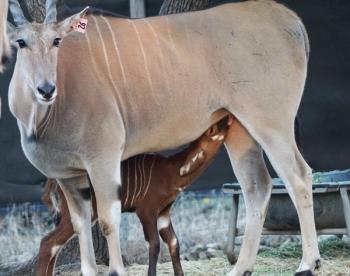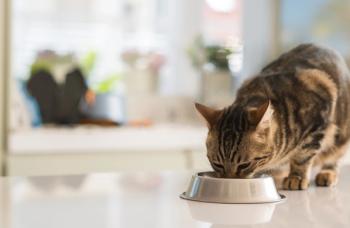
Respiratory disease (Proceedings)
Rabbits with respiratory disease may present with a variety of clinical signs.
Notes
Rabbits with respiratory disease may present with a variety of clinical signs. These may be as subtle as a mild to moderate amount of discharge matted on the medial aspect of the forepaws. This is a result of the rabbit's fastidious grooming behavior of cleaning its face with its forepaws.
Respiratory disease can be caused by bacterial and viral organisms, nasal foreign bodies, neoplasia and heart disease. The most common bacterial etiology is Pasteurella multocida (Harcourt-Brown, 2002). However, other organisms such as Staphylococcus aureus, Enterobacter sp., and Pseudomonas aeruginosa are not uncommon pathogens cultured from rabbits' respiratory tracts. Bordetella bronchiseptica has been reported as a common inhabitant of the rabbit respiratory tract that doesn't usually cause clinical disease (Deeb, 1997). This author has seen rabbits with significant upper and lower respiratory tract disease whose deep nasal and tracheal wash cultures produced a pure growth of Bordetella bronchiseptica. Explanations for this could include the possibility that the rabbits were immune compromised by some other condition, the Bordetella was dominating the culture and other organisms were not able to proliferate, or that Bordetella truly is a primary pathogen of rabbits.
Bacterial infections of the upper respiratory tract are usually characterized by a mucopurulent discharge from one or both nasal passageways. Since the modern-day rabbit owner is usually very vigilant, rabbits may present to the veterinarian at the earliest signs of disease such as an increase in sneezing. At such an early stage of infection the discharge may not be evident on the nose or even on the forepaws. However, close examination of the nasal passageways with an otoscope cone often reveals the discharge. Culture of the discharge alone is often not fruitful in diagnosing the causative agent. A deep nasal culture provides the best specimen. Micro-tipped culturettes are very useful for this purpose. The culturette should be inserted at least 2cm into the nasal cavity. Holding the rabbit in such a manner that it is on its back and slightly tranced, or by using light sedation are two ways to make this feat possible. An otoscope also may be used to explore the rostral aspect of the nasal passageways if the practitioner suspects that an upper respiratory tract infection is being caused by a nasal foreign body. It is not uncommon for a rabbit to get hay or hair up its nose. Until the foreign body is found and removed, treatment will be futile. Rabbits with nasal foreign bodies often present with very copious mucopurulent discharge, especially from the offending side. They also tend to paw at the side of their nose and sneeze forcefully. If a foreign body is not recognized on the initial cursory exam with an otoscope and the rabbit has a persistent, intractable URTI exploration of the nasal passageways with a rigid endoscope is indicated and often very useful.
Bacteria also can be responsible for abscesses in the rabbit's chest. These can be very large in size and compromise the lung capacity significantly. Clinical signs may be only tachypnea and a mild to moderate decrease in activity level. If heart sounds are not audible on one or both sides of the chest upon auscultation, a chest abscess or neoplastic mass should be considered as differentials.
Therapeutic agents for the treatment of respiratory infections in rabbits must be considered carefully. Severe dysbiosis and life threatening enteritis can occur if the wrong antibiotic is chosen. Safe antibiotic choices include the fluoroquinolones, enrofloxacin and ciprofloxacin at 5-10mg/kg PO, SQ BID, chloramphenicol at 50mg/kg PO TID, tribrissen at 30mg/kg PO BID, azithromycin at 50mg/kg PO QD X 10-14 days (Plumb, 2002) and parenterally administered penicillin at 42,000-84,000IU/kg SQ, IM q 24h (Carpenter, 2001).
A very useful adjunct to systemic antibiotic therapy is the use of nebulization. Antibiotics, a mucolytic agent, a broncodilator and saline can be combined for this therapy. The following recipe has been very useful: 5ml of saline, 0.25cc of 20% acetylcysteine, 0.5cc of amminophylline (25mg/ml), and 1ml of amikacin. The rabbit is nebulized with a mask over its nose. This treatment can be repeated every 4-12 hrs. Even the most distressed rabbits seem to tolerate this treatment quite well.
The most common viral disease that can affect the rabbit's respiratory tract is myxomatosis. Rabbits infected with this virus may present with rhinitis and ocular discharge. Transmission of the myxoma virus is vector mediated. Common vectors include fleas and mosquitoes. A vaccine (Nobivax Myxo, Intervet) is available and affords good protection from this disease. The vaccine protocol is injection of 0.9ml of the vaccine subcutaneously and 0.1ml of the vaccine intradermally (Harcourt-Brown, 2002). The intradermal route utilizes the Langerhans cells in the dermis as antigen-presenting cells that increase the activation of T-helper cells. This intradermal route also protects the antigen by minimizing its diffusion into surrounding tissues and providing a depot effect (Stills, 1994).
The most common neoplasias of the chest cavity include metastatic mammary adenocarcinoma and thymomas of either lymphoid or epithelial origin. There have been several reports of surgical removal of such masses via throacotomy (Vernau, 1995, Clippinger, 1998., Harcourt-Brown, N., 2002). A case is currently undergoing radiation chemotherapy at Cornell University. The rabbit's chief problems were dyspnea, exercise intolerance and a moderate bulging of the eyes. Thoracic radiographs revealed a very large mass silhouetting with the heart. After two weeks of receiving two radiation treatments per week, a follow-up CT scan showed a 77% reduction in tumor size (Morrissey, 2002).
Heart disease is becoming more commonly diagnosed in the pet rabbit. This is due partly to the fact that many house rabbit owners are bringing their rabbits in for regular wellness exams before the animals are severely clinical for disease. In the author's practice arrhythmias have been ausculted more commonly than murmurs. Chest radiographs, echocardiograms and electrocardiograms are useful diagnostic tools in managing heart disease in rabbits. Due to their small chest size, rabbit chest radiographs can be challenging to read, but when significant heart disease is present the heart often appears amazingly enlarged. Normal rabbit echocardiogram measurements are presented in Table 1 (Redrobe, 2002).
Table 1
It is difficult to find established rabbit dosages for heart medications in the literature. In the author's practice a rabbit with dilated cardiomyopathy was managed with enalapril at 0.5mg PO QD, digoxin at 0.03mg/kg PO BID and furosemide at 0.5-0.8mg/kg PO BID for 7 months before decompensating and dying from heart failure. Another patient is currently being managed for premature atrial complexes. A significant arrhythmia was detected on physical exam when the patient presented for a mild mucopurulent discharge from his nose. Chest radiographs were within normal limits, but an EKG showed a significant number of PACs and a heart rate of 300bpm. The only clinical sign the rabbit had other than the mild nasal discharge was minor weakness of the rear limbs. Considering that the patient is nine years old, this change may be associated with the cardiac disease or may be due to other changes associated with aging. The patient was initially started on 0.75mg/kg of diltiazem given orally once daily. After it was determined that the rabbit was tolerating the drug well (no inappetance, lethargy or other negative changes) the dosage was increased to 0.75mg PO a.m. and 1mg/kg PO p.m. After 4 days the dose was increased to 1mg/kg PO BID. At a recheck appointment in November 2002, the EKG revealed a completely normal rhythm and a heart rate of 300. At the time of this visit, the right testicle was notably enlarged. Since this change had come about extremely rapidly and the patient was doing so well, castration was recommended. The patient was premedicated with 1.5mg of diazepam and 2mg of ketamine, intubated and maintained on isoflurane anesthesia. The operation went well and the patient recovered and went home the same day. An EKG was run before and after the procedure and no PACs were noted.
Another 9 year old rabbit presented for a dermatological condition. Auscultation of the chest revealed extremely muffled heart sounds. Echocardiogram showed a large, 9cm fluid-filled mass at the base of the heart. Approximately 60 milliliters of a dark brown fluid was removed via ultrasound guided thoracocentesis. Cytology of the fluid was consistent with a septic effusion. The pathologist surmised that this was possibly a liquefying abscess. A culture of the fluid grew a coagulase negative Staphylococcus. After the thoracocentesis, the rabbit was treated with ciprofloxacin at 10mg/kg PO BID and furosemide at 1.2mg/kg PO BID for two weeks. The mass did not fill with fluid again and the rabbit lived for another six months.
Although bacterial infections account for the majority of respiratory diseases in pet rabbits, many rabbits that present with clinical signs of respiratory disease often have other problems such as neoplasia, heart disease, or a foreign body in the nose that are the primary disease process. A thorough physical exam and diagnostic testing such as radiographs, tracheal washes, culture, endoscopy, and ultrasound are helpful in identifying the cause of illness.
References:
Carpenter J.W., Mashima T.Y., Rupiper D.J. Eds. Exotic Animal Formulary (second edition). Philadelphia: W.B. Saunders, 2001; p 304.
Clippinger, T.L., Bennett, A., Alleman, R., Ginn, P.E., Bellah, J.R. Removal of a Thymoma Via Median Sternotomy in a Rabbit with Recurrent Appendicular Neurofibrosarcoma. J AM Vet Med Assoc. 213 [8], 1998, pp1140-1143.
Deeb, D. Respiratory Disease . In: Hillyer, E.V., Quesenberry, K.E., eds. Ferrets Rabbits and Rodents – Clinical Medicine and Surgery. Philadelphia: W.B. Saunders, 1997; p198.
Harcourt-Brown, F. Textbook of Rabbit Medicine. Oxford: Butterworth Heinemann, 2002.
Harcourt-Brown, F., Harcourt-Brown, N., Surgical Removal of a Mediastinal Mass in a Rabbit., Exotic DVM, 4.3, ICE proceedings 2002, pp59-60.
Morrissey, J., Cornell Veterinary College, personal communication, 2002.
Plumb, D.(ed.), Veterinary Drug Handbook, Ames, Iowa, Iowa State University Press, 2002.
Redrobe, S. Imaging Techniques in Small Mammals, Seminars in Avian and Exotic Pet Medicine, 10[4], 2001, pp.187-197.
Stills, H.F., Polyclonal Antibody Production. In: Manning, P.J., Ringler, D.H., Newcomer, C.E., The Biology of The Laboratory Rabbit. New York: Academic Press, 1994; p. 437.
Vernau, K.M., Grahn, B.H., Clark-Scott, H.A., Sullivan, N. Thymoma in a Geriatric Rabbit with Hypercalcemia and Periodic Exopthalmus. J AM Vet Med Assoc. 206[6] 1995, pp820-822.
Newsletter
From exam room tips to practice management insights, get trusted veterinary news delivered straight to your inbox—subscribe to dvm360.






